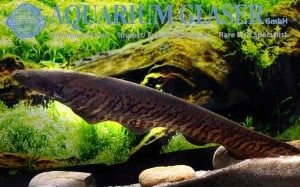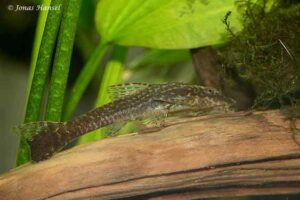Osteogaster melanotaenia – Green Gold Catfish
Osteogaster melanotaenia was first described by Charles Tate Regan in 1912. This fish belongs to the family Callichthyidae, which is known for the armored catfish. The family Callichthyidae consists of several genera, including the genus Osteogaster, which has recently been revised and now includes Corydoras melanotaenia. They are also known as Green-golden Corydoras. However, in 2024, they were moved from the genus Corydoras to Osteogaster.
The genus name Osteogaster is derived from the Greek words “osteon” (bone) and “gaster” (belly), referring to the bony structure of these fish. The species name Melanotaenia is derived from the Greek words “melano” (black) and “taenia” (band or ribbon), referring to the black stripe that runs along the body of the fish.
Synonym: Corydoras melanotaenia
Description
General Description:
Osteogaster melanotaenia has an elongated body, featuring a metallic green coloration on its upper half and a light yellow underside. Its fins are particularly striking, displaying a golden or yellow hue, especially when the fish is in good condition. This species can grow up to 6 cm in length.
Differences between males and females:
Females are generally rounder and broader than males, especially when laden with eggs. Males typically have more pointed fins, while females possess more rounded fins.
Behavior and temperament:
Osteogaster melanotaenia is a peaceful fish ideal for community aquariums. They thrive in groups of at least six, which enhances their confidence and activity. As bottom dwellers, they spend most of their time at the aquarium’s floor.
Intestinal Breathing:
Several species in this family, including Osteogaster melanotaenia, have a unique ability to breathe through their gut. This means they can inhale atmospheric air by swallowing it and directing it to their gut, where oxygen is absorbed through the highly vascularized lining. This adaptation allows them to thrive in oxygen-poor environments, such as stagnant or polluted water. In an aquarium, you may observe them swimming quickly to the surface for a gulp of air. This behavior is normal and should not be a cause for concern unless it occurs frequently, as it may indicate poor water quality.
Biotope
Natural distribution:
Osteogaster melanotaenia is a species native to Colombia, particularly found in the Meta River basin.
Habitat:
These fish inhabit small tributaries, streams, flooded forest areas, and sandbanks. Their natural habitat features water with a pH level between 6.0 and 8.0, and a temperature range of 23 to 25°C. The substrate typically consists of sand or fine gravel, and there is often underwater vegetation, such as Java moss.
Diet
Diet in the wild:
In the wild , Osteogaster melanotaenia feeds on worms, benthic crustaceans, insects, and plant material.
Diet in the aquarium:
In the aquarium, they can be fed a varied diet of live, frozen, and dry foods. It is important not to overfeed them and to avoid foods that can quickly deteriorate water quality.
The Aquarium
An aquarium of at least 60 centimeters and 60 liters is suitable for a small group of six fish. A larger aquarium is recommended for larger groups.
The aquarium should be set up with plenty of hiding places and plants such as Java moss. A sand or fine gravel substrate is ideal.
Water parameters:
The best water parameters for Osteogaster melanotaenia are a pH of 6.0-7.2, a water hardness of 2-15 dGH, and a temperature of 20-23°C.
Compatibility:
Suitable tank mates include small characins, tetras and peaceful catfish.
Breeding aquarium and conditioning
A special breeding tank of 45x30x30 cm is ideal. Use an air-driven sponge filter and maintain a temperature of approximately 24°C and a pH of 6.5. Condition the fish with a varied diet of live food such as black mosquito larvae.
The spawn
During spawning, the fish’s colors become more intense. The eggs are usually laid on plant leaves or the glass of the aquarium. A single spawn can yield 150-180 eggs, which are ivory-colored and about 1.5 mm in size.
Triggering Spawning:
Spawning can be triggered by performing a large water change (50-70%) with cooler water and increasing oxygenation and flow in the tank. This simulates the conditions of the rainy season in their natural habitat, which stimulates breeding behavior.
T-position:
The mating ritual of Osteogaster melanotaenia features a behavior known as the T-position. In this position, the male fish grasps the female’s barbels between his pectoral fins and body. He then releases sperm, which is guided through the female’s mouth and gills to her pelvic fins. These fins create a ‘basket’ where the female lays one single egg or up to four eggs. After laying the eggs, the female swims away in search of a suitable place to attach them.
Raising the fry
The eggs hatch after about five days. The fry begin to swim freely after a week and can then be fed microworms and later newly hatched brine shrimp.
Conclusion
Osteogaster melanotaenia is a beautiful and peaceful fish that is well-suited for community aquariums. They are relatively easy to keep and breed, provided the right conditions are provided. Their interesting behavior makes them a valuable addition to any aquarium.
Keeping Osteogaster melanotaenia requires some attention to water quality and nutrition, but their peaceful nature and social behavior make them a pleasure to care for. They are suitable for both beginners and advanced aquarium enthusiasts.
Video
Author
John de Lange
Copyright images
J. de Lange










